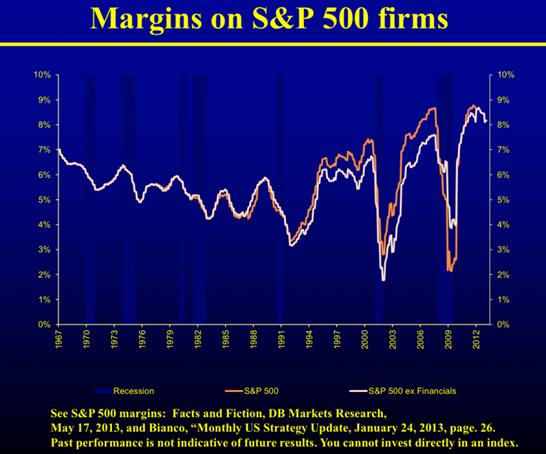Corporate profits are now higher than they’ve ever been before!
At first glance, this might seem like a good thing; except, here’s the problem: whenever profit margins reach a high, they often peak and then dramatically crash before the stock market and economy follow in like manner.
When Business Insider asked Wall Street’s best and brightest to produce what they considered to be “the most important charts of the year,” Blackstone’s Vice Chairman, Byron Wein, sent the following and said, “This chart worries me. Profit margins are at a peak and they appear to be rolling over. This could mean trouble…”
MarketWatch’s Mark Hulbert similarly warned in August of last year that with profit margins at record highs, any sizeable decline “would almost certainly translate into big losses for the stock market.”
With many analysts and well-known commentators raising the alarm, a number of our followers have asked us to comment.
Here are a number of observations and conclusions by analyzing sixty years of data corresponding to corporate profit margins, the stock market (using the S&P 500), and recessions (see chart below for reference):
- Corporate profit margins can remain at elevated levels anywhere from a single quarter to multiple years and don’t typically present an imminent warning threat to the stock market or economy until forming a major peak and sudden decline.
- Historically, profit margins peak on average before the stock market by more than a year and before recessions by more than two years.
- Two notable exceptions: Profit margins peaked with the market in the 1970-1973 period and then, only once, after the stock market during the double-dip recession of the early ‘80s.
(Note: There are a few variations of corporate profit margin charts circulating on the web. For an in-depth discussion on why we chose this one, please see the following article at Philosophical Economics.)
So, what do we learn from the above? Corporate profit margins have served, historically, as a decent leading indicator for major market peaks and recessions; however, as usual, one indicator alone should not be used as a timing tool (especially given the potential lag of almost 5 years in the longest case: 1982-1990 period).
For risk-assessment purposes and confirmation of a major market peak and/or coming bear market, investors should watch for a simultaneous breakdown in, at least, the following three areas:
- Corporate profit margins
- Credit market spreads
- Economic data
For a further discussion of the last two items, please see “Is a Major Correction and Bear Market around the Corner?” Currently, none of these three have yet to break down and, in the case of credit market spreads, are still at very healthy levels.
To gain unrestricted access to all our premium interviews on the markets and economy, please login or CLICK HERE to subscribe. In addition to hearing from money managers, institutional investors, and other experts regularly interviewed for FS Insiders, you’ll also gain access to our entire archive of past interviews with noted heavy-weights like Kyle Bass, David Rosenberg, Gary Shilling, Marc Faber, and more.







